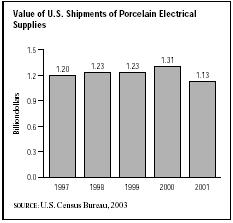SIC 3264
PORCELAIN ELECTRICAL SUPPLIES
This category consists of manufacturers of porcelain electronic insulators, molded porcelain parts for electrical devices, other electrical insulators, ceramic electronic and electrical supplies, and spark plug and steatitic porcelain.
NAICS Code(s)
327113 (Porcelain Electrical Supply Manufacturing)
Unlike other pottery product industries, the porcelain electrical supplies industry relies on high technology. Only the base material, clay, makes it similar to other pottery products. The products manufactured in this industry are ideal insulators for electrical currents because of the way they dissipate heat. The United States has the technological edge in most electronic ceramic components used in these high performance markets.
The value of product shipments in this industry rose steadily in the late 1980s, from $759 million in 1987 to $936 million in 1990. Due in part to the decrease in U.S. military spending, the value of product shipments dropped in the early 1990s, to $927 million in 1991. The industry experienced rapid growth in the mid-1990s, however, as the value of product shipments reached $1.4 billion in 1995, dropping somewhat to nearly $1.2 billion in 1997. Porcelain electrical supply shipments climbed back to $1.3 billion in 2000, but then declined to $1.1 billion in 2001. The worldwide advanced ceramics market was estimated to be worth between $10 and $11 billion in 2003, according to the U.S. Advanced Ceramics Association, with U.S. companies dominating the industry overall.
In 2000 there were 10,093 people working in the porcelain electrical supplies industry, 7,961 of whom were production workers. The wages for production workers totaled $13.08 per hour in 2000, in line with the national average for production workers in manufacturing. Professional staff in the industry includes inspectors, metrology and process workers, and application engineers.
The Adolph Coors Company, whose primary business is malt beverages, was also making technical ceramics at a separate facility until late 1992, when the brewery became a separate company. Coors Ceramics Company, which was one of the largest U.S.-owned manufacturers of technical ceramics, became a part of the holding company called ACX Technologies. Although company outputs were primarily absorbed by Adolph Coors Company, sales for ACX fell more than 20 percent, from $910 million in 1995 to $712 million in 1996. Coors Ceramics represented about 30 percent of ACX net sales in 1995, with $271 million. In 1999, ACX Technologies posted $988 million in sales, and Coors Ceramics Company posted $300 million. Eventually, ACX Technologies changed its name to Graphic Packaging International. Coors Ceramics, which became known as CoorsTek, Inc. after its spin-off from ACX in 2000, posted sales of $350 million in 2002.
Many of the companies working in this industry also made engineering supplies that were not porcelain based. Some of the companies were small job shops making small quantities of a specific product and others were large international corporations. Brush Wellman Inc., for example, made beryllium ceramics and beryllium alloys used as insulators for microelectronics. These products represented only about 10 percent of their business. Brush Wellman posted sales of $200 million in 2002.
Some of the latest technology employed by manufacturers in this industry included dry press production

equipment, automation such as computerized tool control systems and computer-aided design, high volume tunnel kilns, and statistical process control that was integrated on a network. Precision operations included grinding, lapping, and polishing.
Further Reading
U.S. Advanced Ceramics Association. Advanced Ceramics Technology Roadmap: Charting Our Course. Washington, DC: December 2000. Available from http://www.advancedceramics.org/ceramics_roadmap.pdf .
U.S. Census Bureau. "Statistics for Industry Groups and Industries: 2000." February 2002. Available from http://www.census.gov/prod/2002pubs/m00as-1.pdf .
——. "Value of Shipment for Product Classes: 2001 and Earlier Years." December 2002. Available from http://www.census.gov/prod/2003pubs/m01as-2.pdf .
Comment about this article, ask questions, or add new information about this topic: